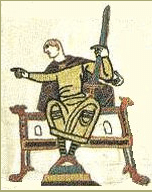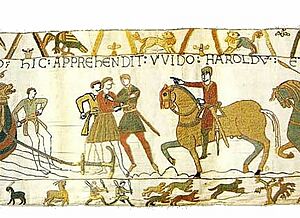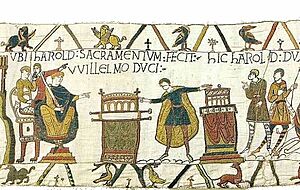Guy I, Count of Ponthieu facts for kids
Guy I of Ponthieu (also known as Wido in the famous Bayeux Tapestry) was born in the 1020s and passed away on October 13, 1100. He became the Count of Ponthieu after his brother, Enguerrand, died.
Contents
Guy's Early Life
Guy was the son of Hugh II, Count of Ponthieu and Bertha of Aumale. Around 1053, he took over as Count of Ponthieu. His brother, Enguerrand II, had married Adelaide of Normandy, who was the sister of Duke William of Normandy. This marriage helped create an alliance between Ponthieu and Normandy. However, the marriage was later ended because they were too closely related, which was not allowed by the church.
Conflicts and Battles
Guy's sister was married to William of Talou, Duke William's cousin. In 1053, William of Talou built a strong castle at Arques and challenged Duke William. The family from Ponthieu, including Guy, supported this rebellion.
Duke William put Arques under siege, meaning he surrounded it to cut off supplies. He knew that King Henry of France and the Ponthieu army were coming to help William of Talou. Guy's brother, Enguerrand, led the Ponthieu army first. Duke William surprised them in an ambush, and Enguerrand was killed. When King Henry heard this, he pulled his soldiers back to France. William of Talou had to give up Arques and was sent away for good.
After his older brother Enguerrand died without any sons, Guy became the Count of Ponthieu. This is the first time Guy is mentioned in history books.
Capture at Mortemer
In February 1054, King Henry of France decided to punish Duke William again. He entered Normandy with a large army, joined by Count Geoffrey of Anjou. This combined force moved towards Rouen. Meanwhile, King Henry's brother, Eudes, led a second army, which included Guy and Count Rainald.
This French and Ponthieu army was not well-organized. They spread out to steal and raid the countryside around Mortemer. Suddenly, Norman soldiers from Eu attacked them. In the Battle of Mortemer, Guy's younger brother Waleran was badly hurt and later died. Guy himself was captured. He was held prisoner in Normandy for two years. During this time, his uncle, Bishop Guy of Amiens, ruled Ponthieu in his place.
From this point on, Count Guy became a loyal follower, or vassal, of Duke William of Normandy.
Harold Godwinson and the Norman Conquest
Harold's Shipwreck and Oath
In 1064, Harold Godwinson, a powerful English earl, was shipwrecked on the coast of Ponthieu. Count Guy captured him and took him to his castle at Beaurain. The Bayeux Tapestry shows this event, saying: "Here Guy seized Harold and led him to Beaurain and held him there."
Duke William of Normandy demanded that Harold be released. Count Guy let Harold go after Duke William paid him a ransom. Harold was not allowed to leave Normandy until he swore an oath on holy relics. He promised to be Duke William's vassal and help him become the King of England. The Bayeux Tapestry clearly shows this story, calling Guy "Wido."
The Battle of Hastings
In 1066, Edward the Confessor, the King of England, died. Harold Godwinson then accepted the crown of England for himself. This decision started a war that led to the Norman Conquest of England.
Some historical accounts suggest that Hugh, another of Guy's brothers, fought in the Battle of Hastings. He may have even played a part in Harold's death. Guy I had a son named Enguerrand, who likely died before 1068. When old writings mention Hugh as the "noble heir of Ponthieu," it suggests that Enguerrand had already passed away.
Guy's Family
Guy married a woman named Adela. They had three children:
- Enguerrand (died in the 1060s), who passed away before his father.
- Agnes, who married Robert of Bellême. Their son, William III of Ponthieu, became Count of Ponthieu after Agnes died, sometime before 1111.
- Matilda




